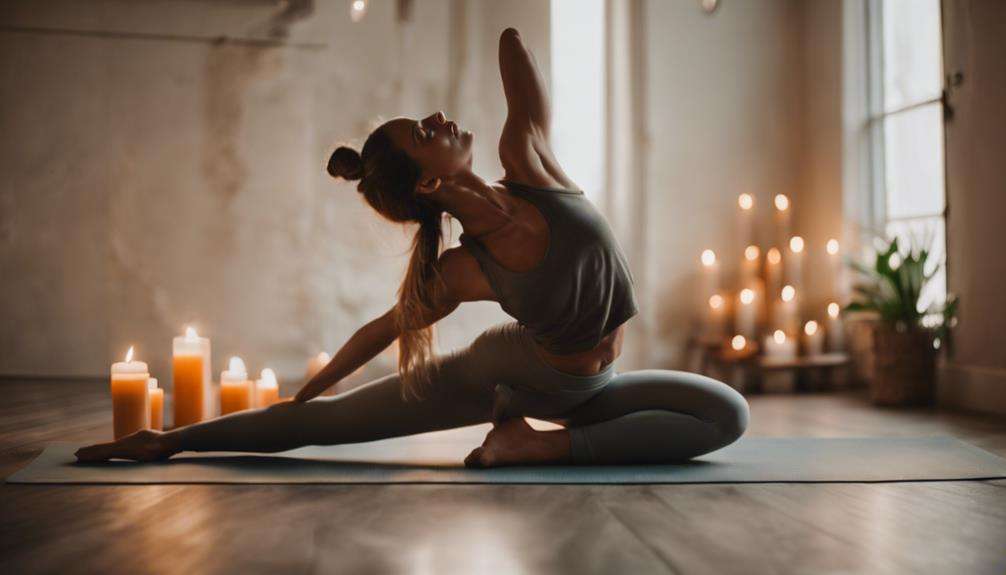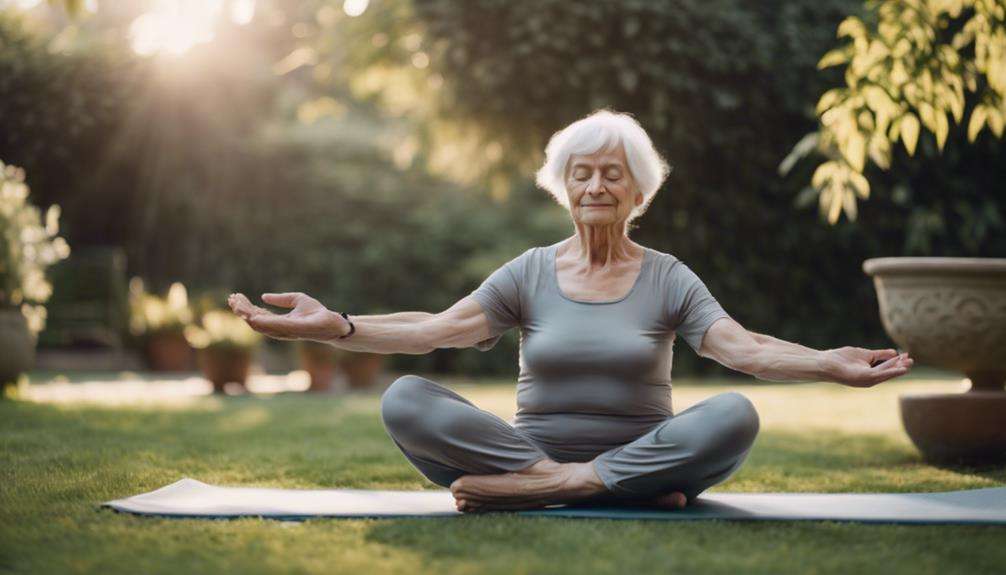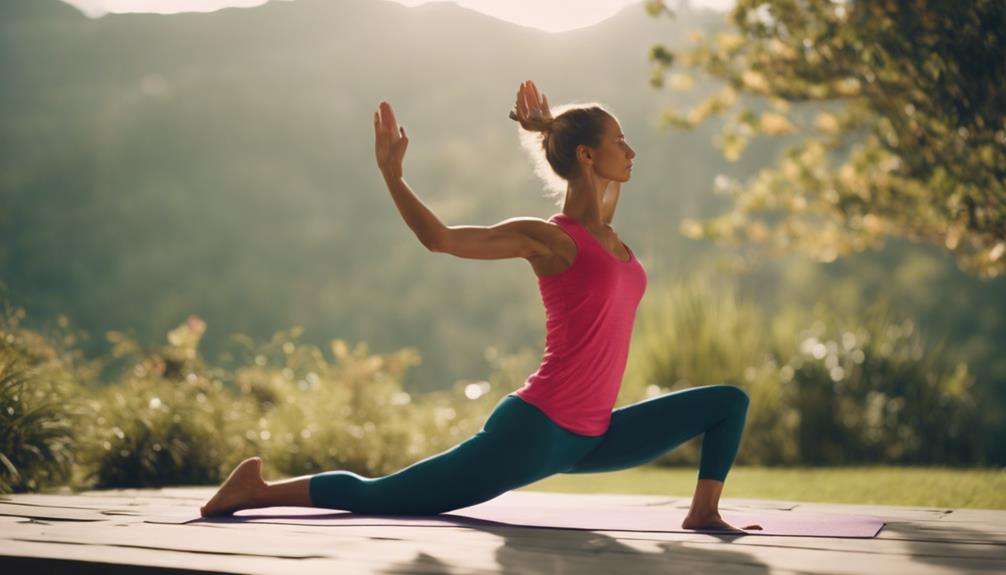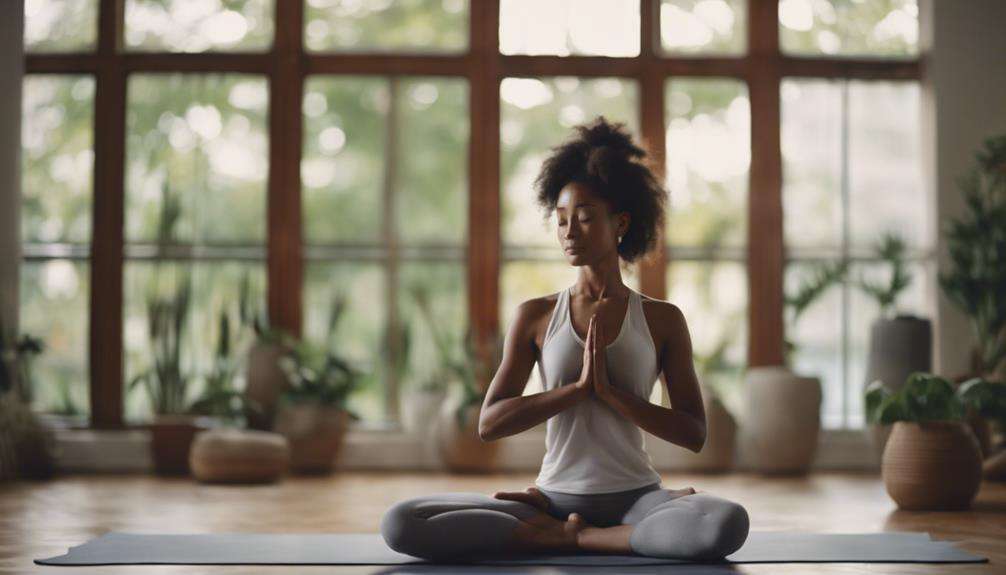Did you know that studies show that incorporating mindfulness techniques into your flexibility routine can not only improve physical flexibility but also enhance mental well-being?
Imagine a practice that not only stretches your body but also calms your mind. How can mindfulness transform your ordinary stretching routine into a holistic wellness practice that benefits both your body and mind?
Explore the connection between mindfulness and flexibility and discover how simple yet effective techniques can elevate your overall well-being.
Key Takeaways
- Mindful movement enhances physical and emotional well-being, promoting flexibility and reducing stress.
- Breath awareness in yoga aids in releasing tension, promoting relaxation, and improving flexibility.
- Body alignment focus prevents injury, deepens stretches, and cultivates a strong mind-body connection.
- Mindfulness improves flexibility, reduces stress, and fosters physical and mental well-being for holistic wellness.
Benefits of Mindful Movement
Indulging in mindful movement can significantly enhance your physical and emotional well-being through a combination of stretching, strengthening, and toning muscles. By incorporating mindful practices into your routine, you aren't only improving your physical health but also nurturing your mental well-being. Mindful movement serves as a powerful tool for stress reduction, allowing you to cultivate a sense of body awareness and presence in the moment.
Engaging in this practice enables you to develop a deeper connection between your mind and body, leading to a more holistic approach to wellness. Through mindful movement, you can reduce tension in your muscles, improve flexibility, and enhance overall mobility. This heightened body awareness can help you better understand your physical capabilities and limitations, promoting a sense of self-care and self-compassion.
Furthermore, the emotional benefits of mindful movement are vast, as it can assist in regulating your emotions and promoting a positive outlook. By integrating this practice into your daily routine, you can experience improved focus, reduced stress levels, and increased mental clarity.
Mindful Yoga Practices
When practicing mindful yoga, focusing on breath awareness helps you stay present in each pose and enhances the mind-body connection.
Paying attention to body alignment ensures you perform poses correctly, reducing the risk of injury and maximizing the benefits of each movement.
Incorporating these aspects into your mindful yoga practice can deepen your experience and enhance overall wellness.
Breath Awareness in Yoga
Enhancing your yoga practice with mindful breath awareness can deepen your connection between movement and relaxation. By focusing on your breath during yoga, you can experience a myriad of benefits:
- Improved Oxygen Flow: Deep breathing techniques enhance oxygen circulation in your body, supporting overall well-being.
- Enhanced Flexibility: Mindful breath awareness can help release tension in muscles, allowing for greater flexibility during poses.
- Stress Relief: Aligning breath with movement promotes relaxation, reducing stress levels and calming the mind.
- Activation of Parasympathetic Nervous System: Deep breathing activates the body's rest-and-digest response, fostering a state of calmness.
- Mind-Body Connection: Synchronized breathing cultivates a stronger connection between your physical movements and mental focus, enhancing the overall yoga experience.
Body Alignment Focus
Mindful yoga practices emphasize precise body alignment to optimize flexibility and minimize the risk of injuries. Proper alignment in yoga poses is crucial for improving posture, muscle balance, and joint mobility. By aligning your body mindfully during yoga, you can prevent strain on muscles and joints, ensuring a safe and effective practice.
Being aware of your body alignment in yoga poses not only deepens the stretch but also maximizes the benefits for overall wellness. Engaging in mindful body alignment cultivates a strong mind-body connection, enhancing the effectiveness of your yoga practice.
Mindfulness for Physical Wellness

How can incorporating mindfulness practices into your physical wellness routine benefit your overall health and well-being?
Mindfulness plays a crucial role in enhancing physical wellness by improving flexibility, reducing stress, and promoting mental health. When you integrate mindfulness into your physical activities, you experience a range of benefits:
- Mindful stretching techniques not only increase flexibility but also enhance blood circulation, ensuring better oxygen supply to muscles.
- Engaging in mindful movement helps release muscle tension, promoting relaxation and reducing stress levels.
- Mindfulness fosters awareness of your body, allowing you to focus on the present moment and improve your overall physical performance.
- Mindfulness-based programs have shown significant success in reducing stress levels and enhancing psychological flexibility.
- Practices like yoga, stretching, and breathing exercises not only contribute to physical well-being but also support mental health, creating a holistic approach to wellness.
Incorporating mindfulness into your physical routine can lead to improved physical and mental well-being, making it a valuable addition to your overall health regimen.
Flexibility Through Meditation
Meditation offers a pathway to enhanced flexibility through calming your mind and relaxing your muscles. By focusing on your breathing, you can deepen your stretches and improve joint mobility.
Connecting your mind and body through meditation can optimize your flexibility and overall physical wellness.
Calmness for Flexibility
Cultivating a sense of calmness is essential for enhancing flexibility through mindful practices. By incorporating meditation into your routine, you can experience a range of benefits that contribute to improved flexibility.
- Stress Reduction: Meditation helps reduce stress levels, which can lead to tension in muscles and hinder flexibility.
- Body Awareness: Through meditation, you can enhance your awareness of different parts of your body, facilitating better flexibility.
- Deep Breathing: Deep breathing techniques during meditation increase oxygen flow to muscles, aiding in flexibility.
- Enhanced Mental Focus: Regular meditation sessions improve mental focus, allowing for better concentration on flexibility goals.
- Mind-Body Connection: Mindful meditation strengthens the connection between your mind and body, enhancing overall flexibility and range of motion.
Breathing and Flexibility
Enhance your flexibility through mindful breathing techniques during meditation sessions. Deep breathing techniques can relax muscles and increase oxygen flow to tissues, aiding in improving flexibility.
By incorporating breathwork into stretching exercises, you can release muscle tension, allowing for a greater range of motion.
Mindful meditation supports flexibility by calming the mind, enhancing body awareness, and strengthening the mind-body connection.
During stretching sessions, practicing deep breathing exercises can help you achieve a deeper stretch and enhance your flexibility over time.
Mind-Body Connection
Strengthening the mind-body connection can significantly boost your flexibility through mindful practices like meditation. By engaging in meditation regularly, you can enhance your flexibility by promoting relaxation and reducing muscle tension. Mindful meditation practices specifically target improving range of motion and joint mobility, aiding in releasing both mental and physical stiffness.
The mind-body connection established through meditation is instrumental in enhancing overall flexibility and posture. Techniques employed in meditation, such as breath awareness, contribute to gradual increases in body flexibility over time. Embracing meditation as part of your wellness routine can lead to tangible improvements in your flexibility and overall physical well-being.
Mindful Stretching Techniques
Incorporate Progressive Muscle Relaxation techniques into your mindful stretching routine for effective stress relief and relaxation. Mindful stretching, combined with PMR, allows you to release tension systematically throughout your body. By focusing on tensing and then relaxing specific muscle groups, you can promote a sense of calmness and reduce anxiety.
Yoga poses offer a great way to deepen your mindful stretching practice. These poses not only enhance flexibility but also contribute to mental wellness by encouraging mindfulness and presence in the moment. Whether at home or at your desk, integrating yoga poses into your routine can help alleviate stress and improve overall well-being.
When practicing mindful stretching, consider customizing your stretches to suit your preferences. This personalization can make the routine more enjoyable and effective. Additionally, starting your session with deep breathing exercises sets the tone for relaxation and mindfulness, enhancing the benefits of your stretching practice.
Yoga Poses for Flexibility
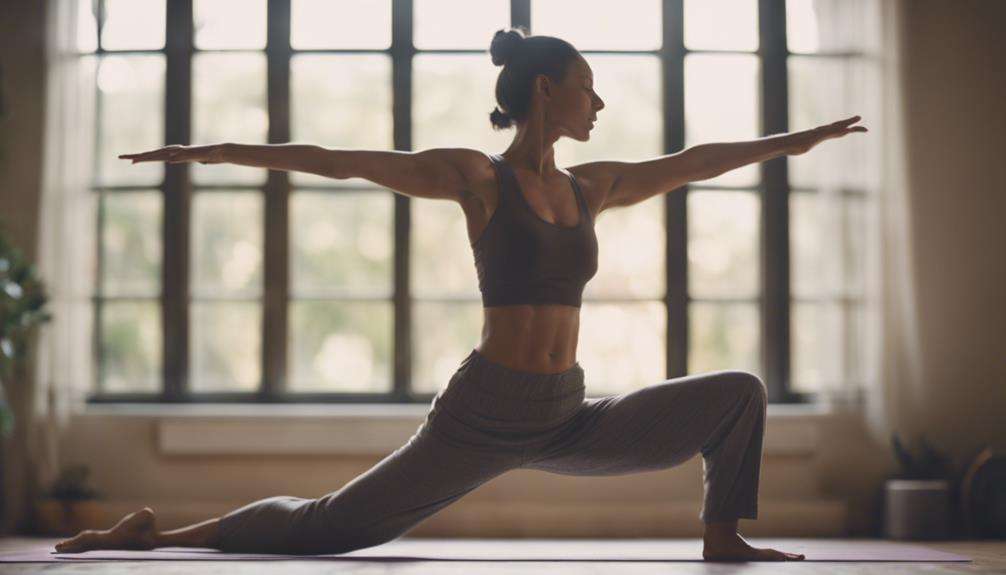
As you explore the realm of flexibility through mindful practices, delving into specific yoga poses can significantly contribute to your overall physical and mental well-being. Yoga is a powerful tool that combines movement with breathwork and mindfulness practices to enhance flexibility while nurturing the body and mind. Here are some key yoga poses that can help you improve flexibility as you focus your attention on your daily activities:
- Downward Dog: Stretches the entire body, including the hamstrings and shoulders.
- Warrior II: Strengthens the legs and opens the hips, enhancing lower body flexibility.
- Triangle Pose: Stretches the hamstrings, hips, and side body, improving overall flexibility.
- Child's Pose: Releases tension in the back and shoulders while promoting relaxation.
- Cobra Pose: Opens the chest and stretches the front body, enhancing spinal flexibility.
Incorporating these poses into your daily routine can't only increase physical flexibility but also cultivate mental clarity and body awareness.
Mindfulness for Body Awareness
When practicing mindfulness for body awareness, focus on your breath and movement to connect with your body on a deeper level.
Utilize sensory awareness techniques to tune into physical cues and better understand your body's needs.
Incorporating gentle stretching exercises can help improve flexibility and reduce the risk of injury.
Breath and Movement
Enhance your body awareness and mindfulness through mindful breath and movement practices. When you combine breath with movement, you foster a deeper mind-body connection, allowing you to focus on physical sensations and reduce stress. Mindful breathing during movement aids in promoting relaxation and overall physical well-being.
To fully benefit from these practices, consider the following:
- Focus on the rhythm of your breath as you move.
- Pay attention to how each movement feels in your body.
- Be present in the moment, letting go of distractions.
- Engage your core muscles to support your movements.
- Remember to breathe deeply and steadily throughout your practice.
Sensory Awareness Techniques
To heighten your awareness of bodily sensations, engage in sensory awareness techniques that encourage mindfulness and presence in the moment. These practices involve focusing on physical sensations through activities like body scans and mindfulness meditation.
By bringing attention to your body, you can deepen your understanding of its signals, emotions, and thoughts. Tuning into your physical experiences without judgment allows you to cultivate a strong connection with yourself. This increased awareness not only enhances your body-mind connection but also improves emotional regulation and overall well-being.
Practice focusing on your physical sensations regularly to develop a heightened sense of attention and focus, leading to a more profound understanding of your body and its needs.
Gentle Stretching Exercises
Engaging in gentle stretching exercises while practicing mindfulness can significantly enhance your body awareness and promote overall physical well-being. When incorporating mindful practices into your stretching routine, you can experience various benefits such as:
- Enhancing body awareness by focusing on sensations and movements.
- Promoting relaxation and reducing muscle tension and stiffness.
- Improving flexibility, range of motion, and posture through gentle movements.
- Releasing stress and promoting a sense of calmness.
- Leading to improved overall well-being and physical comfort.
Enhancing Flexibility With Yoga
Improve your flexibility effectively through the practice of yoga, which incorporates a series of poses and postures aimed at enhancing your range of motion, strength, and balance. Yoga is a versatile practice that not only boosts physical flexibility but also promotes mindfulness through intentional breathing and body awareness during each pose.
By engaging in regular yoga sessions, you can increase your joint range of motion, which in turn reduces the risk of injuries and enhances overall mobility. Various types of yoga, such as Hatha, Vinyasa, and Restorative, cater to different levels of flexibility and individual preferences, making it accessible to everyone.
Scientific studies have shown that yoga not only improves physical well-being but also reduces stress, enhances mental clarity, and boosts overall wellness through its combination of mindful movement and breathing techniques. Embrace the holistic benefits of yoga to enhance your flexibility and well-being effectively.
Meditation for Improved Flexibility
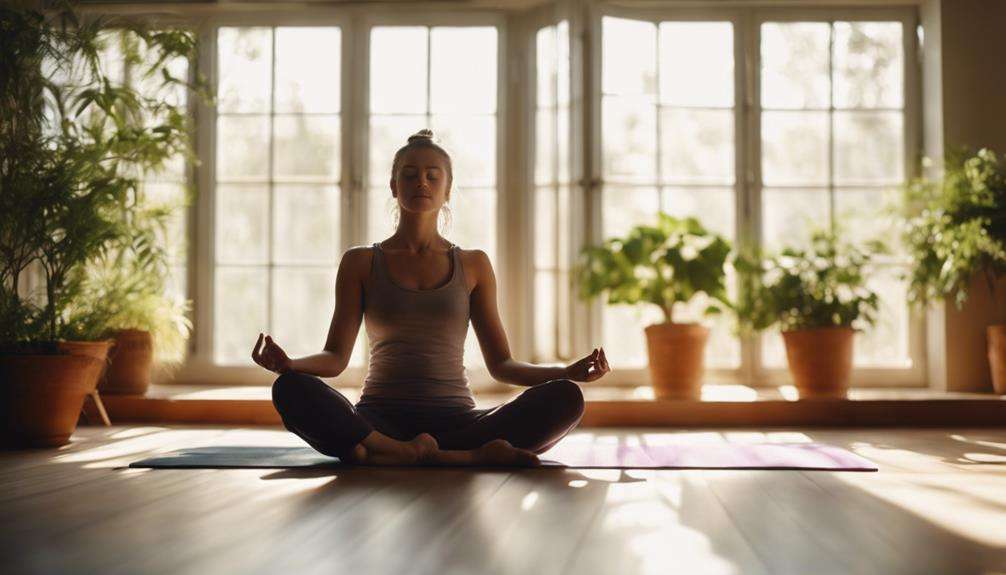
Enhance your flexibility further by incorporating meditation practices that promote relaxation and reduce muscle tension, fostering improved body awareness and alignment. Mindful meditation plays a crucial role in improving flexibility by enhancing your mind-body connection and increasing joint mobility. Here are some key points to consider when using meditation to enhance your flexibility:
- Mindful meditation: Focus on being present in the moment during your meditation sessions to cultivate awareness of your body and its movements.
- Body awareness: Through meditation, you can develop a deeper understanding of how your body feels and moves, allowing for better alignment in your stretching routines.
- Joint mobility: Regular meditation practice can help increase joint mobility and range of motion, leading to improved flexibility over time.
- Mind-body connection: By connecting your mind and body through meditation, you can enhance your overall flexibility and physical performance.
- Stretching routine: Integrating meditation into your stretching routine can enhance the benefits of both practices, promoting better physical and mental well-being.
Mindful Practices for Flexibility
To enhance your flexibility effectively, consider incorporating mindful practices that focus on increasing body awareness and promoting relaxation. Mindful stretching is a powerful technique that not only enhances flexibility by improving blood circulation and oxygen supply to muscles but also helps in reducing stress levels.
Progressive Muscle Relaxation (PMR) is another beneficial practice to include in your routine, as it can release tension in the muscles, leading to improved flexibility. Yoga poses designed for stress relief serve a dual purpose by promoting mental well-being and increasing flexibility through mindful movements.
Even during work hours, engaging in mindful stretching at your desk can prevent muscle tightness and enhance flexibility. By customizing your stretches based on personal preferences, you can make mindful practices more enjoyable and effective in improving flexibility.
Incorporating these mindful practices into your daily routine won't only increase your flexibility but also contribute to your overall well-being.
Frequently Asked Questions
How Can Flexibility Improve Mindfulness?
Flexibility benefits your mindfulness by enhancing mind-body connection, reducing stress, improving focus, and aiding emotional regulation. With increased range of motion, you can engage in mindful movements effectively, fostering a deeper present moment awareness.
What Are Three 3 Things That May Be Improved by Practicing Mindfulness?
By practicing mindfulness, you can enhance stress management, emotional regulation, and relationships. It boosts productivity, self-awareness, and decision-making. Additionally, mindfulness aids in improving focus, creativity, physical health, mental clarity, leading to a more balanced and fulfilling life.
What Are 5 Ways I Can Practice Mindfulness?
To practice mindfulness, try breathing exercises for calmness, body scanning for relaxation, meditation techniques for self-awareness, visualization for focus, and walking meditation for movement and mindfulness combined. These practices enhance your well-being and mental clarity.
Is Stretching a Mindfulness Practice?
Stretching is more than just physical. It's a mindfulness practice—a way to connect your mind and body. By integrating awareness with movement and breath, you enhance flexibility, reduce stress, and boost overall wellness.
Conclusion
Incorporating mindful practices into your stretching routine is like nourishing your body and mind with a soothing elixir of wellness.
By focusing on your breath, releasing tension, and embracing mindfulness, you can unlock the potential for improved flexibility and overall well-being.
So, take a deep breath, stretch with intention, and let mindfulness guide you on a journey towards a more flexible and balanced life.


